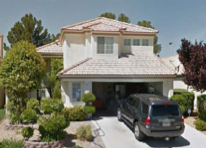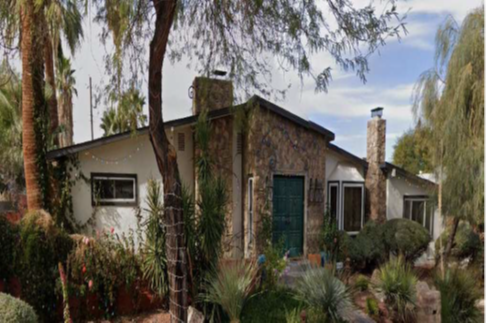SHOCKED! WERE YOU? WHEN YOU STARTED TO SEE ADDITIONAL CHARGES ADDED TO YOUR WATER BILL EARLY 2023?
Representatives from the LVVWD have repeatedly stated that “proper” notifications were sent out in advance of the implementation of the Excessive Use Charges. Turns out that “proper” notification of a rules change only requires a Business Impact Statement (BIS), in other words only businesses needed to be notified for comment. Inexplicably, the residents being impacted had no representation. It was presented that the Excessive Use Charges were set to “target” the top 10 percent of water users to curb consumptive use. No data was provided in the meeting that identified the quantities that made up this 10 percent....It was also shared that the Excessive Use Charges would generate $25 Million in the first year of implementation and that if the Service Rule was adopted that the revenue “would be placed in the District’s financial reserve fund for future needs.” It is interesting that they have stated in several meetings since that the funds would be used for “conservation. ”Las Vegas Valley Water District staff are only required under NRS237.03 through 237.150 to determine the POTENTIAL NEGATIVE IMPACTS of a rule change on the BUSINESS community. IMAGINE, deploying what has been a doubling and tripling of many water bills and only having to consider what might impact businesses? According to the minutes of the September 6, 2022, meeting of the LVVWD BOD, they complied with doing a Business Impact Statement (BIS) which included sending notices to "approximately 70 local trade associations and interested parties" AND, they also posted a notice in the "Las Vegas Review-Journal on a single day...August 3, 2022" -ONE DAY. The comment period available was concluded only 21 days later, August 25, 2022.....that's IT. That is what is being projected as PROPER NOTICE. They had to quietly get over a three-week hump during August and were then free to deploy the most egregious penalty system seen among utility providers to date. Not surprisingly the LVVWD received zero comments from local businesses during the comment period. As expected, it was determined that there was no negative impact to the business community yet no mention of the impacts to the CUSTOMERS who were about to be punished for not converting more of their existing landscapes and accept deed restrictions to their properties. Three commissioners, Commissioner Naft, Commissioner Gibson, and Commissioner Kirkpatrick do not live in Las Vegas and are not impacted by these excessive use charges being that only City of Las Vegas and unincorporated portions of Clark County are subject to these penalties. “Commissioner Kirkpatrick, during the July 2023 Board meeting stated that “she feels for us.” Maybe she and the other commissioners should have abstained, or better yet, required a notice to the residents expected to be impacted well in advance of a vote. At least voters would have known to question the positions of those up for reelection that would take place approximately two months later. Commissioner Jones moved to approve the Business Impact Statement on changes to the District’s water rates and set a public hearing for October 4, 2022. The motion was approved.


On October 4th, 2022, the excessive use charge matter was the last of ten items on the LVVWD Board of Directors meeting agenda.
The meeting was called to order at 9:04 AM and concluded at 9:47 AM…..less than 30 minutes was dedicated to the proper vetting of a request from LVVWD/SNWA and vote to approve penalties for water use that sidestepped the actual customers who were “targeted” and ignored consideration of service agreements and building permits approved on properties already built and improved according to the expectation of affordable utilities. It was stated in the meeting that public outreach had been conducted, including mailers, and media prior to the vote; however, as was outlined previously that outreach only included members of the business community and unknown “interested parties”...The link provided above will take you to the agenda, presentation and minutes and audio of the meeting of October 4th, 2022, where the Las Vegas Valley Water District Board of Directors (Clark County Commissioners) approved the Excessive Use Charges that went into effect January 1, 2023.
The presentation of item 10 included on the October 4th, 2022 Agenda, occurred just thirty days before three members of the Board of Directors, Justin Jones, Tick Segerblom, and James Gibson, would be facing reelection as County Commissioners. Excessive Use Charges were the last of a series of initiatives to reduce daily consumptive water to 86 gallons of water per person per day. By avoiding residential customers in the notification done the previous August, the vote was baked in the cake. For the record and to check the box that requires the final vote to be in a public meeting, subject to open meeting law, a PowerPoint presentation was given by John J. Entsminger, General Manager.
A few noteworthy items to point out from the 20-minute presentation:
Slide 8 states that “homes with water efficient landscaping largely use water indoors with minimal impact to water resources.”
……resources that we are paying for whether used indoors or outdoors. By water becoming unaffordable in quantities needed for life outdoors, the ability to maintain existing property values and quality of life will be limited to only the very wealthy. The average citizen is left without the opportunity to aspire to a balanced home life.
Environmental Science—The life of plants, The plants of life
Slide 9 States that water used in outdoor landscaping is “not recoverable.”
A simple understanding of earth science makes known that water is part of a hydrologic cycle. To say that water used outdoors is “lost forever” as stated by Mr. Entsminger on February 22, 2023, during a presentation to the Assembly Committee on Natural Resources, requires some scrutiny. It is not as if we are exporting water to the moon. Trees and a certain amount of turf are vital to maintain the water content required for healthy air quality. Turf and trees are responsible for converting CO2 into Oxygen. Per the presentation, from January to October 2022, 5 mil square feet of grass was removed in Southern Nevada. With CO2 getting the blame for a warming planet and with Las Vegas ranking number two in heat increase trajectory (Reno is number 1), is this something to celebrate? And as recently witnessed, the benefits of turf in specific areas mitigate erosion. Rain activity during the year resulted in rocks flowing into the streets across the valley. A little fact about natural turf; a 50’ X 50’ area of grass takes CO2 and generates enough oxygen to meet the needs of a family of four. It is worth noting that much of the natural turf that has been removed has been replaced by artificial turf bringing temperatures into an ecosystem that measure within one degree the temperature of asphalt, is toxic, has been responsible for heat stroke, and has come under scrutiny and even been made illegal in certain communities. Resource Link | Science Direct By all accounts the continued removal at this scale will exacerbate temperatures and compromise mature trees when removed out from under their canopies and is visible all over the valley. Imagine how much worse these conditions would be had we not received over 9.25 inches of rain since January. And it is counterintuitive that the SNWA recently approved a budget to incentivize 15-gallon tree installations, offering an additional $100 in its conversion scheme. These 15-gallon trees will take decades to provide the benefits of our existing urban tree canopy and require elevated levels of water to become established. Southern Nevada’s historic canopy is being compromised after having been installed and nurtured for generations by private citizens.
Resource Link | nevadacurrent.com
Resource Link | Review Journal

| Typical Usage | Jan Bill 9,000 gal |
Apr Bill 10,000 gal |
Jul Bill 11,000 gal |
Sep Bill 11,000 gal |
|---|---|---|---|---|
| 2023 Bill | $51.02 | $54.21 | $54.21 | $58.67 |
| w/TE | $51.02 | $54.21 | $54.21 | $58.67 |
| w/EUC | $51.02 | $54.21 | $54.21 | $58.67 |
| w/TE+EUC | $51.02 | $54.21 | $54.21 | $58.67 |

| High Usage | Jan Bill 44,000 gal |
Apr Bill 33,000 gal |
Jul Bill 42,000 gal |
Sep Bill 43,000 gal |
|---|---|---|---|---|
| 2023 Bill | $251.12 | $181.31 | $238.43 | $244.77 |
| w/TE | $251.12 | $181.31 | $238.43 | $244.77 |
| w/EUC | $521.79 | $334.70 | $364.74 | $398.15 |
| w/TE+EUC | $521.79 | $334.70 | $364.74 | $398.15 |
When a property is developed, it is subject to requirements established by a governing body and may include such things as frontage depth, type of structure, lot dimension and minimum lot area per family, to name a few. It is also taxed accordingly. To disregard and create a uniform water allocation standard or an expensive penalty system to force compliance after the fact is outside the boundaries of the normal standards of development and can only be justified in an emergency. Per the Las Vegas Valley Water Act 1947, Section 16 states, “In establishing the rates, the Board shall consider the equitable allocation and recovery of costs of providing facilities and delivery of water service, except that the rates may be established in such a way as to encourage the conservation of water....During presentations given by Mr. Entsminger, he discusses the “cost” to the District to process and deliver water being $3.70 per 1,000 gallons. (The excessive use charges are $9.00 per 1,000 gallons, nearly three times the underlying established rates) The 2023-2024 budgets established this past May reflect cash reserves as just under $1.5 Billion between both LVVWD and SNWA. Multiple people with expertise in water management suggest that the current water supply provides water availability for 127 years for Clark County’s current population of approximately 2,500,000 residents. The argument to implement “conservation” measures that restrict water availability below a single threshold has been the ring around Lake Mead. Open conversations about growth and its impact on water supply along with the goals and objectives of the County in a public setting have not been the main thrust of the reasons behind the crack down on water use. Projections for growth provided by UNLV in a report dated June 2021, Resource Link | CBER UNLV ,that was prepared for the RTC, SNWA, SO NV Regional Planning Coalition and members of the Forecasting Group predicts Clark County’s Population to be 3,383,000 by 2060. People well versed in the math associated with identifying the water needs of a population are concluding that all that will be available per person absent additional water sources being identified and utilized, will be 25 gallons of water per person per day.
It is time to get serious and say enough of the smoke and mirrors and behavior compliance initiatives created to be able to check a box and allow more growth. Desired growth does not constitute an emergency. Desired growth must pay for itself as it does growth in any business. On this path, we will run out of the last drop of water and will have destroyed quality of life, investments, and futures, not to mention turning Southern Nevada into a hell hole getting there. We need water security. And that translates to WE NEED AN ADDITIONAL SOURCE OF WATER besides the Colorado River.


At a recent Water Summit hosted by SNWA and Congresswoman Susie Lee in August, there was a celebratory mood on display over having entered into an agreement with Nevada, Arizona, and California to collectively reduce water use by 3 million acre-feet by the end of 2026. Under this agreement Nevada’s share would be reduced by as much as one-quarter of its normal share. After all the conservation measures put in place by Southern Nevadans, it seems that those negotiating on our behalf need to sharpen their elbows....California, due to its failure to execute plans that have been on their books since the 1960’s, has allowed enough water to flow into the ocean that would have filled both Lake Powell and Lake Mead just since January this year. If all states were coming from the same place related to investments in conservation, this agreement would be much easier to accept. However, thanks to past leadership at SNWA and LVVWD, investments made should require others who have failed to act to catch up before the Silver State shares another drop of water.
And here’s a bit of history that will make this all even more fun. In 1964, President Lyndon Johnson put forth an initiative to investigate desalination technology already being used by Israel to bring water security to the West. It was shot down and dismissed in favor of “conservation.” A position that denies abundance and rations shortages. It has become an all-too-common theme in which creating abundance is not pursued as a solution for growth.……Water is life and our future depends on a change in perspective that makes opportunity and prosperity available to all of humanity. Rationing scarcity is not a winning strategy for accommodating an increasing need for housing and jobs……when water security is absent, so is security in all other aspects of life.
Resource Link | Areo Magazine
Administrative law, and its associated codification, is rooted in the foundation that voters ultimately have authority over bureaucracies because they are overseen by elected officials. When the rules of engagement are used against the public and punishment is used to force compliance, when emergency actions are taken where no emergency exists, should that not be confronted with vigor? In a word, YES. The drought is over, there is no emergency. Resource Link | Drought Monitor...
The LVVWD BOD (Clark County Commissioners) are allowing the LVVWD to go outside its lawful limitations under false pretense to create the illusion of an emergency and are stealing from the citizens of Clark County. Is more water needed for growth? Yes, particularly to the extent that there is a desire to make room for an additional million residents. But as was pointed out in a ProPublica article dated June 7, 2023, Las Vegas Needs to Save Water. It won’t find it in lawns. https://projects.propublica.org/turf-wars/ that is a separate issue that deserves an open and transparent conversation that has so far been a behind closed doors, don’t bother the little people, activity, where the elite political class knows best, and the end justifies the means.
The Las Vegas Valley District Act 1947
Rates and charges are identified in Section 16 of the Las Vegas Valley Water District Act. The language is provided below:
Sec. 16. Board of Directors: Duty to establish reasonable rates and charges: limitations.
It is the intent of this act that, so far as possible, the principal of the interest on any bonds issued by the District be paid from revenues from the works and properties of the District. The Board shall from time to time establish reasonable rates and charges for the products and services furnished by such works and properties, and no board or commission other than the governing body of the District has the authority to fix or supervise the making of those rates and charges. The rates and charges may be in such forms as, but not exclusively limited to, service charges, monthly commodity charges, late charges, delinquent processing charges, lump-sum installment charges or connection charges. In establishing the rates, the Board shall consider the equitable allocation and recovery of costs of providing facilities and delivery of water service, except that the rates may be established in such a way as to encourage the conservation of water. Service from different sources or to areas which are noncontiguous to the existing service area of the District may be deemed to be different classes or conditions of service for the purposes of this section.
Subject to the limitation that the rates and charges be reasonable, the Board shall fix rates and charges which will produce sufficient revenues to pay the operating and maintenance expenses of such works and properties, the general expenses of the District, the principal of and interest on all outstanding bonds of the district as the same fall due and any payments required to be made into any sinking for such bonds.
The language in the Act makes a distinction between rates and charges, specifically allowing for “rates” to be subject to modification to “encourage the conservation of water.” The Excessive Use Charges are not a rate, but a penalty that is imposed once a threshold is exceeded. This is what is being considered and why legal research is an essential component of holding accountable bureaucratic overreach.